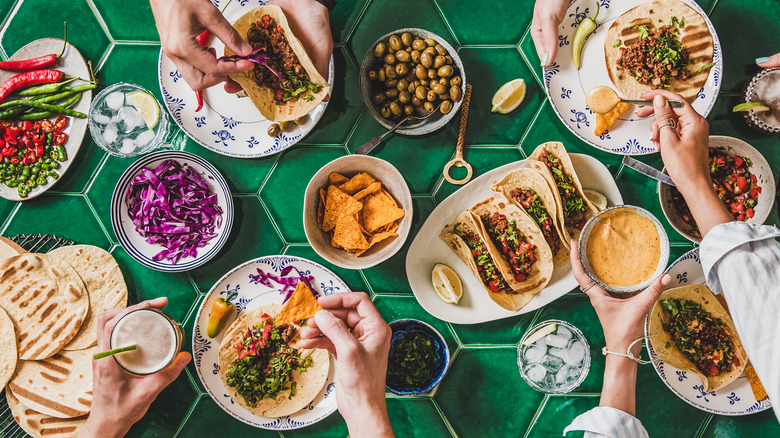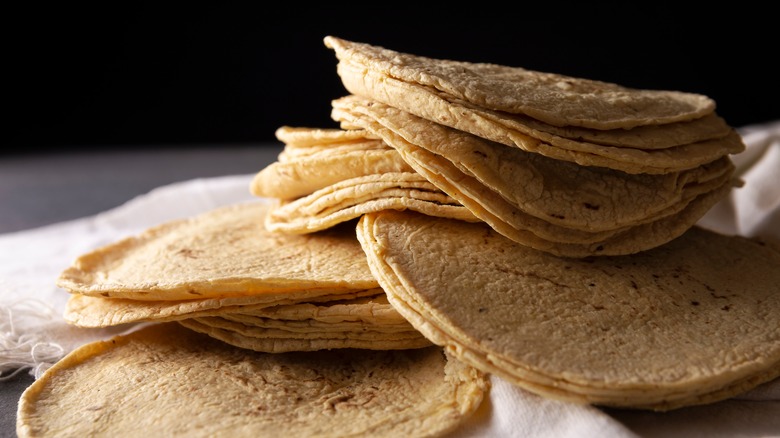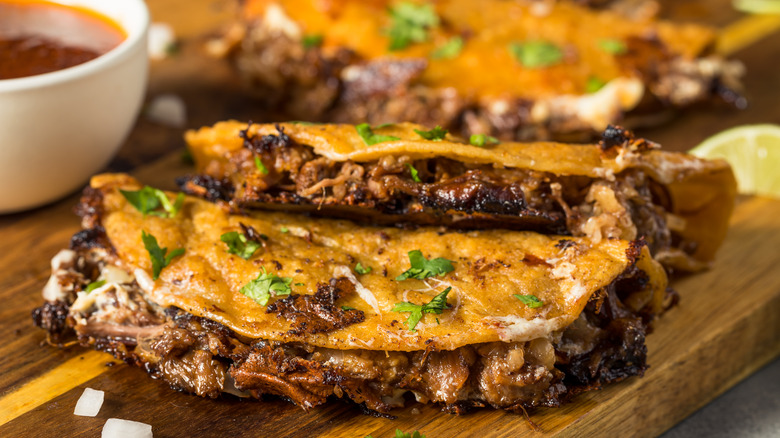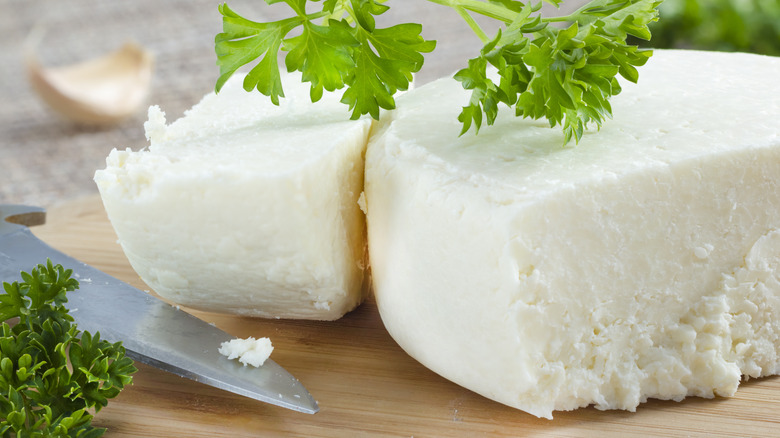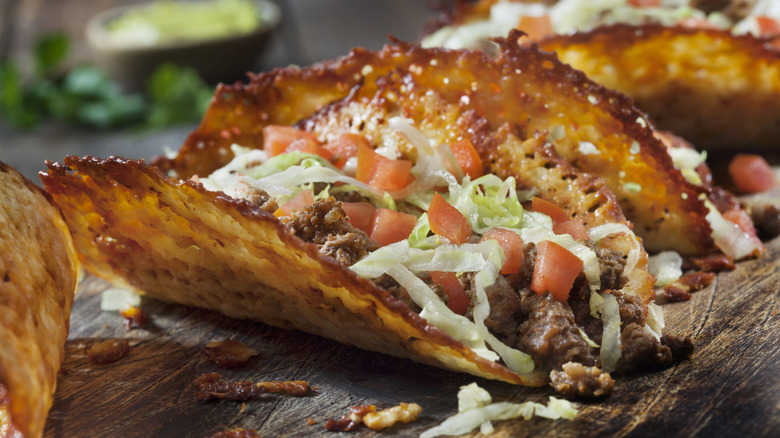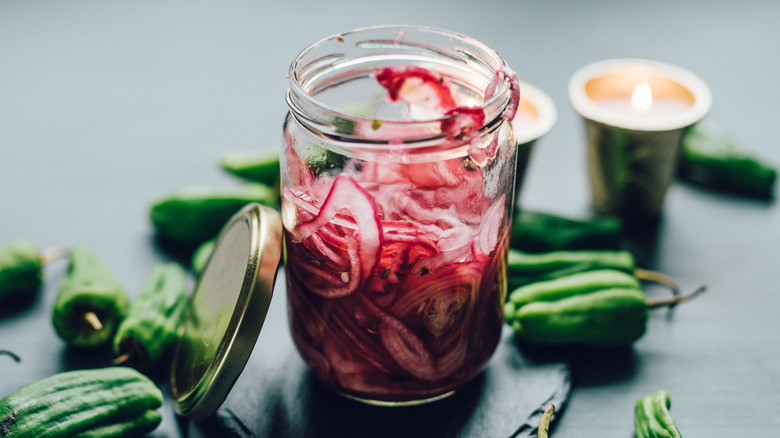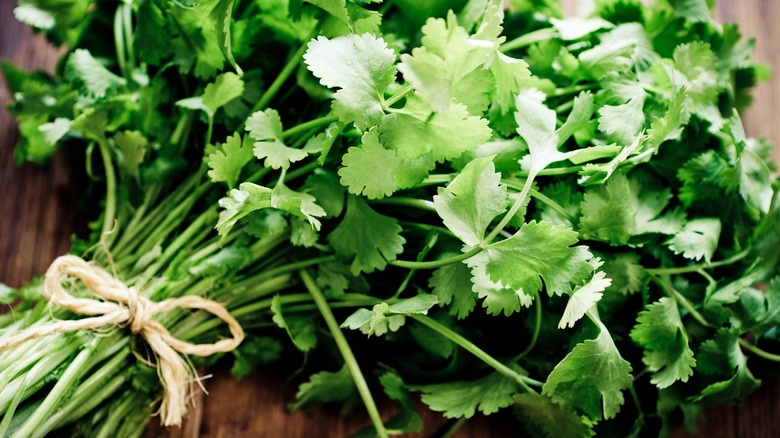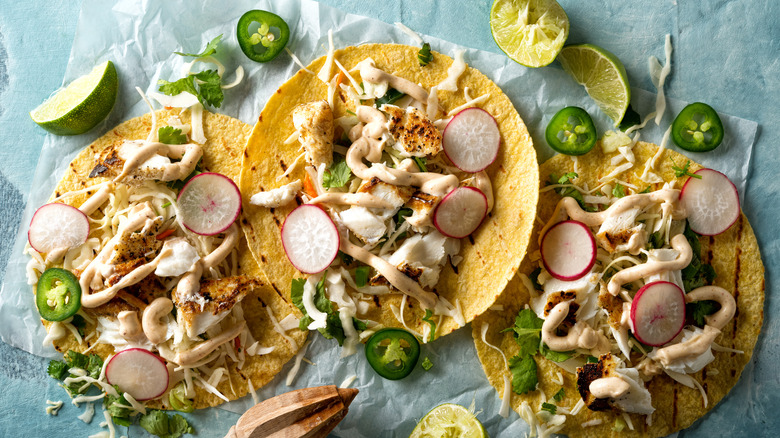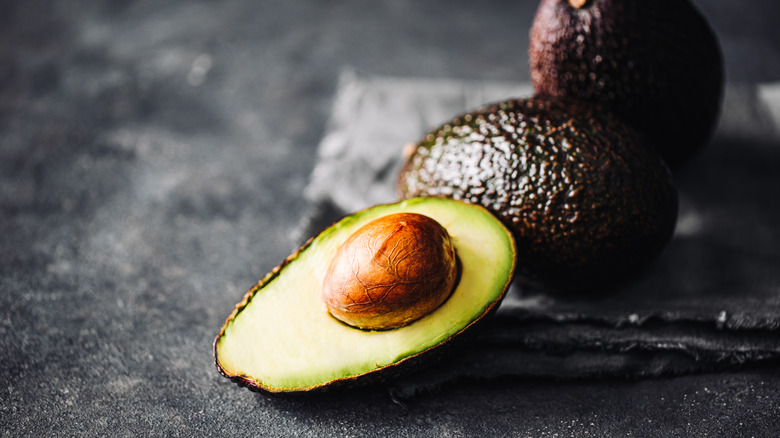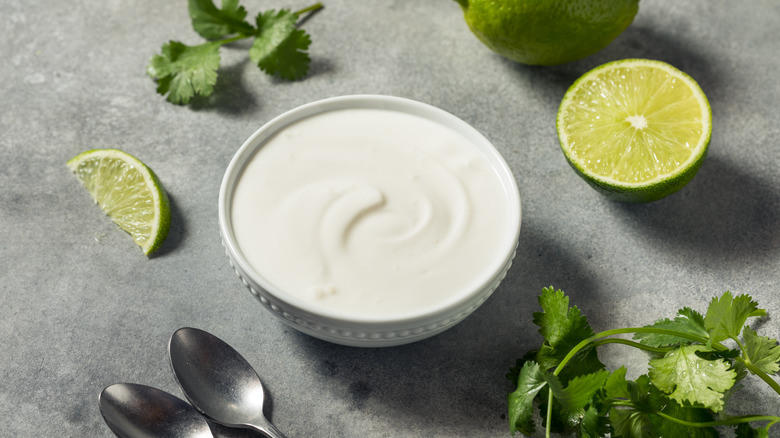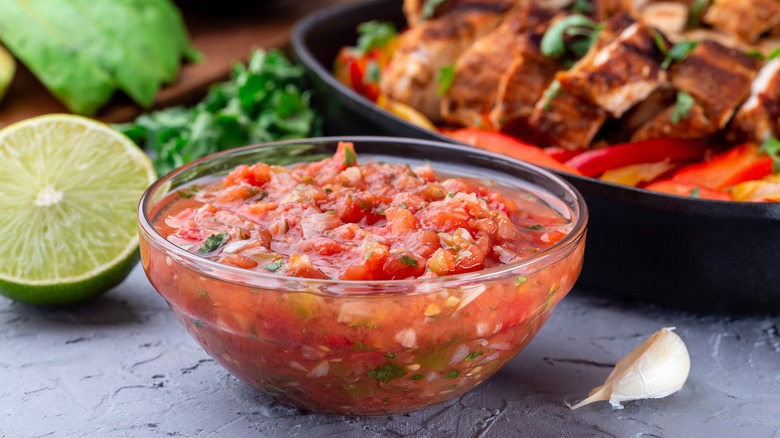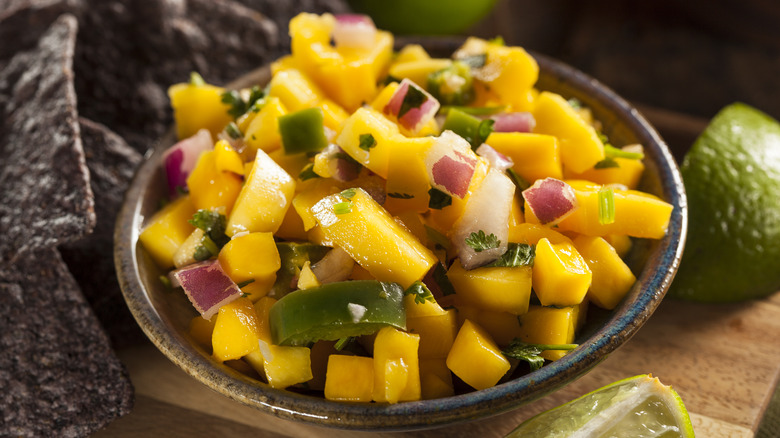12 Best Additions That Will Elevate Your Tacos
Tacos are a worldwide phenomenon, beloved from Mexico to Hong Kong. Americans eat an estimated 4.5 billion of these crunchy munchable snacks every year for breakfast, lunch, and dinner. It's not a mystery why they have ascended in popularity and continue to be a global favorite: Tacos are a symphony in every bite. They're the perfect combination of savory meat, creamy toppings, crunchy textures, and intense spices.
Tacos are easy to make at home and require simple, easily-available, and affordable ingredients. Individual servings can be customized to meet personal preferences, so at-home taco nights and DIY taco bars are smart choices for feeding a family or a big crowd. There are so many ways to make a taco that taco night never gets repetitive — and they're relatively low effort for a big payoff.
Tacos are one of those foods that are good even when they're bad, but why settle for good? Make a few simple swaps to elevate your tacos from good to phenomenal.
Nixtamalized corn tortillas
The foundation for every taco begins with the tortilla. It's the basis for the entire structure and can make all the difference in the quality of the taco. To give your tacos their best start, opt for nixtamalized corn tortillas. In the nixtamalization process, corn is cooked with an alkali — often slaked lime, also known as calcium hydroxide. It's then steeped in the cooking water and then washed to remove the lime. After maize undergoes this process, it results in nixtamal — which is ground and formed into masa to make corn tortillas.
This is the traditional way that Mesoamerican civilizations as far back as the Maya and Aztecs prepared maize for tortillas. The wisdom of these ancient processes should not be discounted. Soaking the corn in the lime softens the outer kernels so that the dough becomes softer and more pliable, desirable qualities for a taco shell. A more flexible tortilla is less likely to break apart as it's wrapped around meat. Nixtimalization also enhances the flavor of the corn meal and even increases the corn's nutritional value by improving the bioavailability of the corn's niacin content.
Purchase freshly made nixtamalized tortillas at your local tortilleria. Or, if you aren't able to source them locally, you can always try making your own. Serve them fresh for pillowy soft tacos that don't fall apart, or fry them up for an audibly crispy crunch.
Shredded meats
Although ground beef is a favorite in fast-food tacos, shredded meats are really where it's at for the ultimate taco filling. Shredded meats hold moisture, soak up sauces, and are meltingly tender.
In order for meat to shred, it must be slow-cooked until it's so soft it can be pulled apart with a fork. That's why you sometimes see shredded meat called pulled pork or pulled chicken. You won't get any tough bits in a batch of shredded meat, because tough meat simply won't shred. Options for achieving shreddable meat include braising, stewing, barbecuing, steaming, or any low and slow method (under 325 degrees Fahrenheit).
A long cooking duration gives the connective tissue in the meat — the collagen — enough time to break down and melt into gelatin. Once it's broken down, the meat becomes extremely tender. The gelatin soaks into the meat to give it a richness that can't be achieved with faster methods. The slow cooking process also gives the meat plenty of opportunity to soak up seasonings and become infused with flavor.
There are a variety of shredded meats that make delectable tacos. If you prefer pork, try pork carnitas. If beef is more your style, opt for beef barbacoa. For one of the fastest options out there, whip up a quick batch of shredded chicken. In the world of taco meat, shredded meat reigns supreme. One bit and you'll never go back to sliced or ground meat in your tacos again.
Consomme
Consomme may not seem like a natural addition to tacos, but it's what made birria tacos the sensational hit of the early 2020s. Birria tacos feature a specific type of stewed, shredded meat with one crucial addition. Originating in Jalisco, Mexico during the 16 century, birria was conceived as a way to make use of nuisance goats imported by Spanish conquistadors. Since goat meat is tough and gamey, birria recipes heavily spiced the meat to disguise its flavor and stewed it slowly to tenderize the protein.
Although it was originally made with goat meat, birria can be made with beef, lamb, or pork. The meat is simmered in a rich consomme broth with guajillo and ancho chiles, tomatoes, onion, garlic, as well as other spices. Once the meat is ready, it's stuffed into tacos. These are then dipped in the stewing broth and pan-fried for extra crispiness. The completed birria tacos are served alongside a bowl of dipping sauce made from the same broth used to stew the meat. Birria tacos are unlike any other taco dish out there.
Recently, birria tacos — and the cheese-infused version called quesabirria — have swept the nation. The unique flavor and visually alluring dipping sauce have spawned dishes like birria egg rolls, birria ramen, and birria beef hash. Meanwhile, the original stewed meat taco with consomme dipping sauce isn't going anywhere. It remains a favorite, and it's a surefire way to spice up your taco Tuesday.
Crumbly cheese
Not all tacos are served with cheese — but if you do choose to include cheese, it's worth choosing a Mexican cheese. We're not talking the pre-shredded Mexican cheese blend that comes in a plastic bag. Opt for traditional cheeses from Mexico like queso fresco, cotija, or queso menonita.
Queso fresco, panela, and cotija are all crumbly semi-firm cheeses sold in large white rounds. Although they look very similar, they have some slight differences. Queso fresco and queso panelo are both fresh cheeses, so they have a light creamy flavor similar to plain cheese curds. One main difference is that queso fresco may contain goat's milk, while queso fresco is a cow's milk cheese. Cotija is also made with cow's milk, but it is aged 2 to 12 months. Because of this, it becomes firmer and drier with a more salty and tangy flavor. Each of these cheeses crumbled nicely onto tacos and offers a creamy compliment to the savory fattiness of the meat.
Griddled cheese
When it comes to cheese, sure you can go for a sprinkle on top, but why stop there? For those who just can't get enough ooey-gooey, melty goodness, try swapping out the tortillas for a taco shell made entirely of cheese. In a variety of taco known as costra (crust), a melting cheese such as mozzarella or gouda is cooked on a griddle until it melts, then crisps, forming a golden, flexible shell. This shell is then used in place of — or less commonly inside of — a tortilla. These tacos sprang up in a Mexico City taqueria named Las Costras, but are now appearing on more and more menus all over the world.
The type of cheese used for costra tacos is a matter of personal preference. But if you enjoy a stringy cheese with superior meltiness and unique flavor, try Oaxacan cheese. Oaxacan cheese is a white, stretched cheese that resembles a ball of string. It has qualities similar to mozzarella. Oaxacan cheese, however, is made exclusively with cow's milk and is not cured in brine.
Onions
Onions are one of the quintessential toppings for traditional street tacos. This simple, pungent vegetable amplifies the garlic and herb flavors present in the taco meat while complimenting the salsa. It's very common to use raw diced white onions sprinkled atop a street taco for an extra boost of flavor (and a slightly sweet vegetable crunch). White onions are best because they're slightly sweeter and their flavor doesn't last as long. Yellow onions, however, will work if you don't have white.
For those who find raw onions too strong a flavor, another option is to use pickled red onions. One trick is to make quick-pickled red onions at the same time you're prepping your other ingredients. Pickling the onions with vinegar and a little (optional) sugar softens the harshness of the onions, but still lets their brightness and crunch come through. Fresh or pickled, red or white, onions make an excellent taco topping.
Fresh herbs
Another very common topping for street tacos is a sprig or two of leafy herbs — usually cilantro, the leafy parts of the coriander plant. Cilantro adds a fresh, citrusy flavor to balance the heaviness of fatty taco meats and fried tortillas. The springy green color livens up the appearance of the tacos. Culantro can add a similar lift to the meal, since it has a similar flavor and aroma to cilantro. However, culantro is a different plant with dark green, serrated leaves and a much stronger flavor. Culantro is better chopped and sprinkled atop a taco rather than served in full sprigs.
If you're one of the estimated 3% to 21% of the population who despises cilantro, you can still add a touch of fresh herbal greenery to your tacos by using Mexican oregano. Mexican oregano is different than Italian oregano. For one thing, true oregano is a member of the mint family related to marjoram, while Mexican oregano is part of the verbena family. That means Mexican oregano is not actually oregano at all. As such, it doesn't have the same peppery bite oregano does. Since it's related to verbena, Mexican oregano is more citrusy and earthy than true oregano. It even has notes of anise. These flavors marry well with lime juice and peppers, which are frequently used elsewhere in taco assembly.
Fresh or pickled cruciferous veggies
You can lighten up the heaviness of your tacos by including cruciferous vegetables, such as shredded red or white cabbage. Fresh red cabbage perks up tacos and balances the richness of the highly seasoned meat. You can also use pickled cabbage, inspired by Salvadorean curtido. Curtido is a fermented white cabbage slaw that traditionally tops pupusas — but makes a welcome palette cleanser on tacos, too.
Sliced fresh radishes give a satisfying peppery crunch and pop of vibrant red. Again, you can opt for sliced raw radishes or use quick-pickled radishes to bring in a touch of acidity. Cruciferous veggies may not seem like an obvious choice for tacos, but many people add cauliflower to the pickled jalapeno and carrot condiment known as escabeche. In each instance, the fresh vegetables offer textural interest and crunchy firmness which contrasts with the tender meats. When using pickled veggies, the acidity of the vinegar cuts the fat, and serves as a refreshing counter to the rest of the taco fillings.
Avocados
There's no substitute for the creamy, grassy, lush texture of a perfectly ripe avocado. Avocados are so mild and refreshing that they can provide a cooling respite from the bold flavors of taco meat and fiery salsas. At its simplest, fresh avocado can be sliced or diced and added to the taco as-is, with no additional fuss. Another option is to mash the avocados into guacamole. You can go traditional and use lime, chiles, and salt. Or you can switch it up and get adventurous with new types of guacamole (such as a charred guacamole). Try throwing in some pepitas, asparagus, basil, or fresh fruit.
For an even creamier avocado taco topping, try making avocado crema. Blend the avocados with sour cream and thin it out with lime juice until it's easy to drizzle onto your tacos. It makes for a pretty plating presentation, and the sour cream makes the already creamy avocado even creamier.
Crema
Perhaps thanks to a certain fast food taco joint, when most people think of a supremely creamy taco topping, they think of sour cream. It makes sense why. The dairy protein (casein) in sour cream tempers the spiciness of taco meats, chiles, and salsas. That's because the capsaicin molecules responsible for chiles' spicy burn bind to pain receptors in your mouth, and casein breaks these bonds, enabling it to wash the pain away in a flood of sweet, milky relief.
Sour cream is a wonderful taco topping, but crema is even better. For one thing, it has a higher fat content so it's creamier than sour cream. It also has a slightly tangier flavor and is a bit thinner than American sour cream, which makes it great for drizzling onto a taco. You can purchase crema premade in jars labeled Crema Mexicana. In a pinch, you can make your own crema by curdling cream with buttermilk and lime juice, then adding salt.
Take it one step further and flavor your crema with lime, chipotle, garlic, or herbs, and add another element to the layered flavors of a taco. You can even whip up a ranch dressing-inspired crema for topping seafood tacos.
Jalapeno salsa
Taqueria-style creamy jalapeno salsa takes any taco from pretty good to amazing. This strikingly bright green, highly addictive jalapeno salsa is ubiquitous at taco stands and Mexican restaurants. Depending on the jalapenos, the salsa can vary in spiciness from a bit piquant to face melting. Though it looks like a creamy green sauce, it surprisingly contains absolutely no dairy. Instead, it uses oil to create an emulsion. It's this ingredient that gives the salsa its creamy appearance and silky mouthfeel.
Recipes vary but the crucial elements are jalapenos, garlic, cilantro, lime juice, and oil. All the solids are pureed into a paste, and then the oil is streamed in at the end to create that all-important emulsion. The slightly smoky flavor of jalapeno peppers dances against the acidity of the lime and the freshness of the cilantro. Although it's pleasantly creamy, the desirable heat of the peppers is undiminished (since there isn't any cream to bind with the capsaicin). This salsa is everything. It's fantastic on fajitas, steaks, as a dip for tortilla chips, and — of course — on tacos.
Tomato Salsa
Tomato salsa is a standard go-to taco finisher. There are endless varieties of this tabletop staple, ranging from finely pureed hot sauce to heartier, chunky versions. Tomatoes are sweet and slightly acidic, so they balance nicely against the spiciness and fat of the other taco components — but their juiciness adds moisture and helps the flavors meld together.
There are a great many store-bought salsas to choose from, but you can take things up a notch by making your own fresh homemade tomato salsa with ripe, roasted tomatoes. You can experiment with adding different herbs, black beans, or corn into the tomato base of your salsa.
For a fresher salsa with a strong kick of spice, try topping your tacos with pico de gallo. This straightforward, chunky salsa features roughly equal parts chopped tomatoes, jalapenos, and onion with a little bit of salt, lime, and cilantro. The large amount of peppers and onions makes it less sweet than the more tomato-forward salsa styles. The result is a lighter, fresher, take on tomato salsa.
Whichever variety of tomato salsa you choose, using ripe tomatoes, fresh herbs, and freshly squeezed lime juice is the key to making this topping stand out.
Fruit salsa
The most prevalent taco salsas are primarily made with tomatoes, peppers, or both. But fruit salsas also have a long history in Mexico and South America. Fruit salsas often use tropical fruits native to warm climates, such as mango, pineapple, and papaya. These sweet tropical fruits make the salsa sweeter, and will usually use a bigger dose of peppers and onions to balance out the sweetness.
Mango salsa, for example, combines the sweet, slightly tart flavor of mangos with cilantro, red onion, and jalapenos. Pineapple salsa uses garlic and onion to complement the sweet acidity of the pineapples. Peach salsa, papaya salsa, berry salsa, and kiwi salsa all rely on a similar combination of fruit, peppers, garlic or onion, and herbs. Fruit salsas are especially tasty as an accompaniment to seafood tacos, but the combination of sweet and spicy is a winner on pork, chicken, or vegetarian tacos too.
It may feel strange — at first — to use a tropical fruit instead of tomato. But tomatoes are botanically a fruit, after all. So you can feel free to use other fruits in their place, and feel free to innovate new salsa flavors using any fruit you choose.
